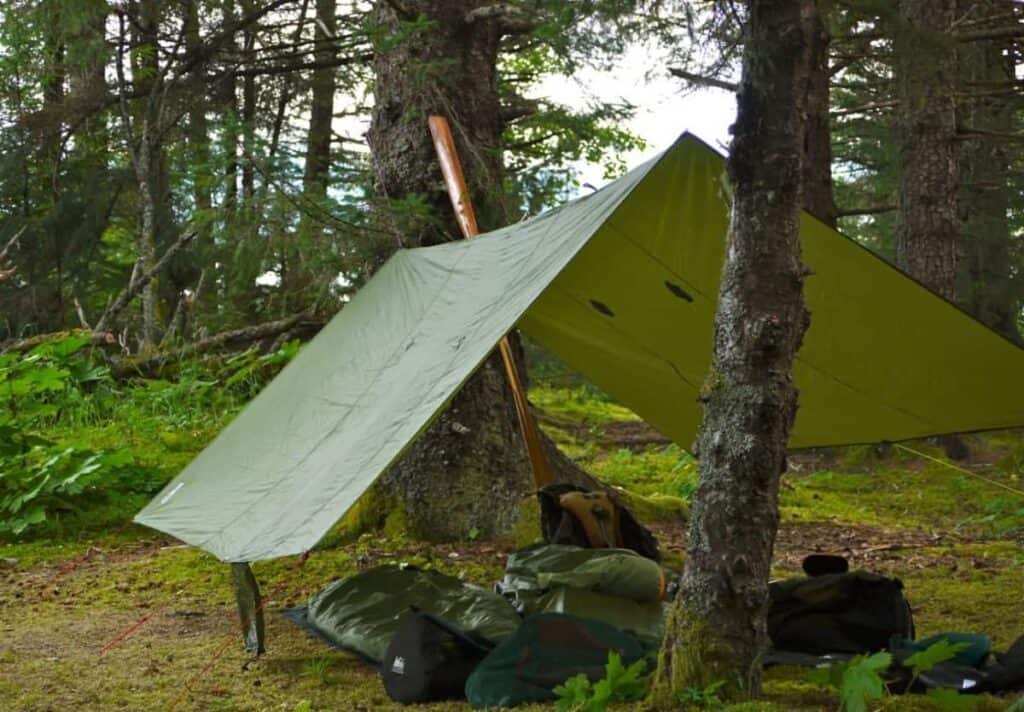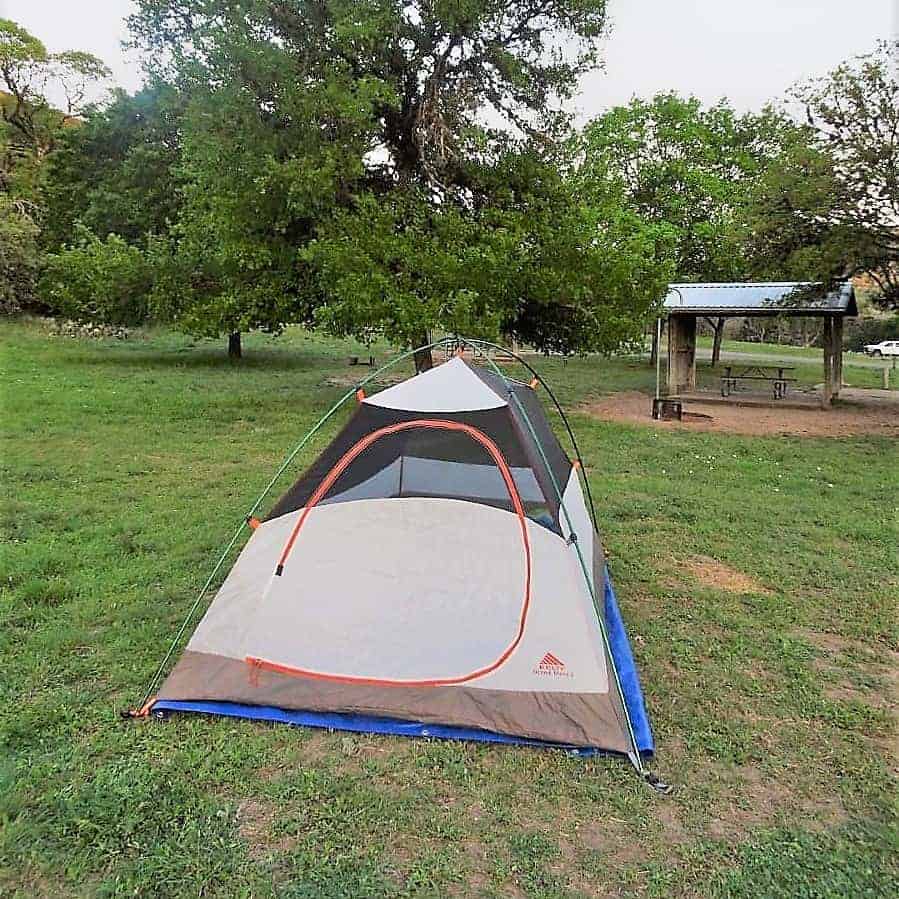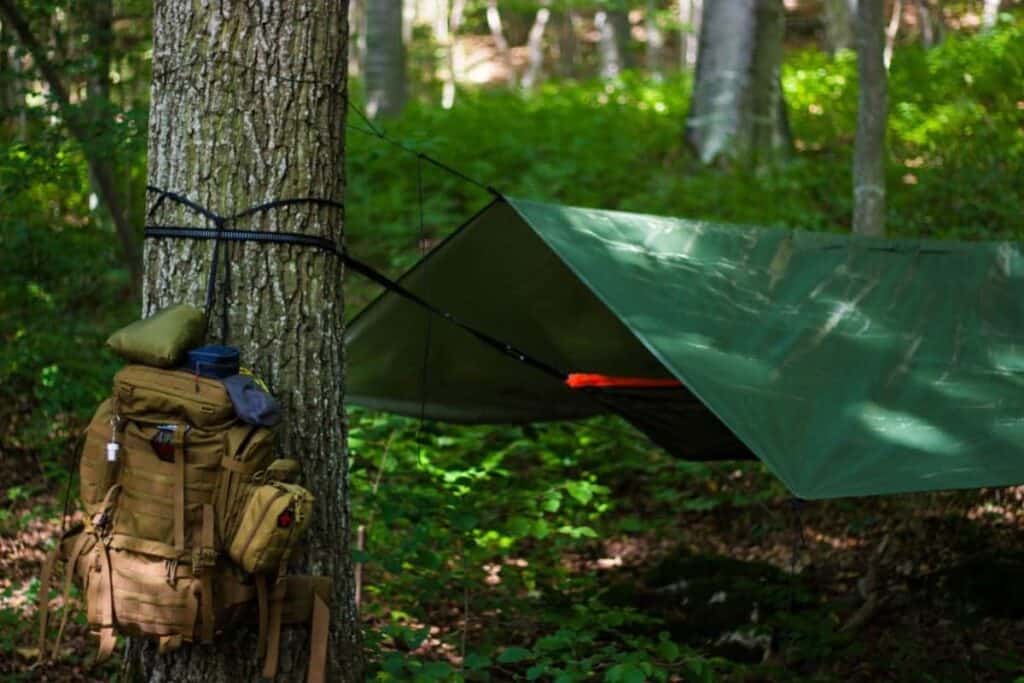It’s easy to take for granted that we have a lightweight, waterproof surface called a tarpaulin (tarp) that we can fold up and put in our cars. Generations ago, settlers and pioneers would have paid a dear price for a tarp we can pick up at Walmart for $5 bucks.

The definition of a tarp is simply a large waterproof cloth. In the old days a tarred canvas would be the only option for waterproofing a cloth, but nowadays there are many more available materials, but most being an impermeable synthetic material.
Why do I need a tarp then? A tarp is an extremely versatile tool because of its lightweight, waterproof, and flexible characteristics. A few of the reasons you need a tarp for camping are these:
By the way, as an Amazon Associate, I earn when buying qualified products through links on my site.
- Shelter
- Ground Cloth
- Windscreen
- Hammock Cover
- Hammock
- Stretcher
- Substitute Wheelbarrow
- Blanket
- Clean Working Surface
- Shade Canopy
- Keep Firewood Dry
- Collect Rainwater
- Beach Blanket
- Truck Bed Cover
- Emergency Signal
1. Using a Tarp As a Shelter

If you want to impress your friends, you can arrive to your campsite without anything at all but a tarp. If you save your money by not purchasing a tent, you can spend more money on the a tarp that has the impermeability and durability you’re looking for.
How To Set Up a Tent As a Shelter
You can go for the A-frame style of a tent shelter, which is suspended by one guy line, and then secured by guy lines along the sides and corners. The tent guy lines can be staked down with tent stakes, or you can opt for wrapping around the cord around rocks to ensure rain will not flip and flap your tarp in the wind.
For an awesome list of tent shelters, waldenlabs.com has a great post showing multiple designs.
If you are looking to use a tarp as your primary mode of shelter, then you will want to make sure your tarp is up to the task.
Cheaper Tarp = Less Durability & Waterproof Ability
Blue tarps that you are used to seeing are made from polyethylene, which comes in a variety of different weaves and thicknesses. You can spend more money to get a thicker tarp that is heavier, but more durable and waterproof. A cheap, light tarp will eventually allow water through and is much more likely to get holes from sticks and rocks or whatever it may be subjected to.
There are many other tarp materials, such as silnylon, canvas, or vinyl, and all of them have their own advantages. You can, incredibly, spend over $200 on a tarp. The main attributes that differ between tarp types are durability, waterproof ability, longevity, protection from the sun, flexibility, and weight.
Don’t Try Without Practice
I highly suggest you try making your tarp shelter in your backyard before attempting it while camping. If you are wilderness camping and relying on your tarp for shelter, then make sure you spend the time to get really good at making shelters since your tarp may be the only thing between you, wind, rain, and everything else.
2. Using a Tarp As a Ground Cloth

A tarp is tremendously helpful for protecting the bottom of your tent from rocks and sticks, but it also assists by keeping the bottom of the tent clean from mud as well as can prevent water from seeping through the floor of the tent. Sleeping in pooling water will always result in you getting wet, though, so campsite placement is still very important.
There’s some controversy on whether you should put the tarp on the bottom of your tent, or on the inside of your tent, with the edges folded up, forming a bathtub. Most people opt to put the tarp on the bottom of their tent (which doesn’t mean that’s the only way it should work!).
In any case, a tarp can help protect the bottom of your tent from the elements, and from the friction caused by the people inside. For more details on the benefits of using a tarp on the bottom of your tent, see my post on the subject.
3. Using a Tarp As a Windbreak
Even if you aren’t planning on using your tarp for sleeping in, it can be used as a windbreak. If you have pillars or columns (aka trees), you can use the tarp along with guy lines to form a wall for windy conditions. There are several other traditional tarp shelters designs made for blocking the wind as well.
Tips for Making a Windbreak With A Tarp
Find a method to secure the edges of your tarp, and ensure your edges are as low as possible so wind does not catch inside the tarp. The more distance from the ground, the more difficult it will to anchor your tarp in extremely windy conditions.
Some experienced tarp shelter makers (I learned through researching this that they call it tarpology. Cool eh? I’d love being known as a tarpologist), recommend that if you are using guy lines to secure your tarp, you should wrap your guy lines around rocks, and bury them to prevent the guy lines from pulling out from strong wind.
In high wind, metal grommets (those metal circles in the corners of tarps used for securing the tarp) are considered to be second-rate to sewn grommets.
There are other shelter ideas that do not require tying, such as shown in this YouTube video:
This type of shelter would only be available to you on your own land or on public land. State parks generally frown on you if you cut fallen wood.
4. Using a Tarp As a Hammock Cover

Using a hammock is not as straightforward as you might hope. That’s why you see the term hammock sleep system, because a full hammock setup made to resist the elements can take a lot of gear and knot tying. Since hammocks by design are open to the elements, a tarp is essential for keeping dry if you are planning in sleeping in a hammock.
Tips for Using a Tarp Cover Over Your Hammock
You have many options for how to secure your tarp over your hammock, but here are a couple tips that may help you stay dry:
- Make sure the tarp dimensions extend past the edges of the hammock. Even if the tarp covers your body, water can get the edges wet which will slowly leech its way into the rest of the hammock leaving you cold and damp
- You can tie the tarp up above the hammock as shown in the picture in this section, or you can lay the tarp on the ridgeline. A ridgeline is tied securely between the top edges of a gathered-in hammock (the typical camping hammocks made from parachute-like material are gathered-in hammocks)
- You can make a simple A-frame, or you can create other lines supporting the tarp creating a porch effect.
One of my favorite hammock YouTubers goes into detail on tips for hammock ridgelines as well as guy line techniques here:
5. Using a Tarp As a Hammock
Tarps don’t make great hammocks, but they absolutely can work in a pinch. You can do this by mimicking the design of an actual gathered-in hammock.
A long rectangular tarp will work much better for this, for obvious reasons, but you can probably fold the tarp to make it more rectangular as needed.
At the corners of the rectangular tarp, go a few inches towards the center along the edges, and then tie a strong cord directly across the shorter end of the tarp together. Do this on both sides to create a gathered-in hammock.
Inexpensive tarps are typically not made for comfort, so you may not get the same “ahhhhhh” relaxation feeling when you sit in your crinkly tarp hammock, but it definitely can work in a pinch if you’re looking for a way to hang when you don’t have a hammock.
6. Using a Tarp As a Stretcher For Emergencies
One of the easiest ways to make a stretcher is to use a tarp. A stretcher can be formed by two long poles and a tarp. The tarp is then folded over and under the long poles thus creating a stretcher. The Art of Manliness has very helpful graphic on how a tarp stretcher works.
7. Using a Tarp as a Substitute Wheelbarrow
You should only try this with a heavy-duty tarp. Preferably a tarp that you don’t mind getting damaged. However, a tarp can be extremely useful if you don’t have a wheelbarrow.
One time we bought a half yard of soil, which is an unbelievable amount of dirt. Our plan was to shovel the dirt from the pickup truck to the tarp and then drag it to the backyard. It took two trips, but it was very effective with a couple of us working at it. This method would work for firewood, rocks, or any other heavy thing you need to transport for short distances.
8. Using a Tarp As a Blanket
A tarp is a flexible, impermeable cloth. This means that if you need more crinkly blankets in your life, or you are in a situation where you have not packed enough warm supplies, that a tarp can help trap heat as a blanket.
9. Using a Tarp As a Clean Working Surface
While living in our houses it’s easy to take things like the floor for granted. Your floor typically will not get your things muddy, nor does it allow your things to roll all over the place.
Mother nature doesn’t always provide us with large flat surfaces (although a large rock will do great in this case), and so a tarp can be extremely helpful in this case to lay out your gear. Because a tarp’s surface is typically high contrast, this will help you not lose important but small items.
If you are rearranging your camping bin, your kitchen bin, or your backpack, you can use your tarp to lay out all your gear for reorganizing without getting your gear dirty on the ground.
10. Using a Tarp As a Shade Canopy
This may seem like the tip about tarps and shelters, but this is for a slightly different purpose. Rather than keeping out the rain, a tarp also works a shade.
Even if you have a tent with a rain fly, an additional shade over your tent will help your tent stay cool inside. If you are staying in an area without great natural shade, this can be very helpful in very hot conditions.
Another use is out in the open, such as at the beach. One person on Youtube shared their method here:
11. Using a Tarp To Keep Firewood Dry
If you are camping for a long time, you probably will be using a fair amount of firewood during your trip. Firewood becomes much more difficult to light when it’s wet, so it’s important you have a way to keep your firewood dry. A tarp again, comes to the rescue.
Make sure you have your corners securely underneath your firewood, or weighted down by rocks to prevent wind from catching your tarp and blowing your cover (ba doom psh!).
12. Using a Tarp To Collect Rainwater
The purpose of many tarps is to be a waterproof surface. Even canvas tarps will swell when wet, thus creating a waterproof barrier. However, even though most tarps are waterproof, the tarp shape should promote water running down the sides rather than pooling on top of the tarp.
If arranged properly, a tarp can actually channel water from rain, which can be used to funnel the water into any container you want.
13. Using a Tarp As a Beach Blanket
You can, of course, use a tarp without any dressing as a beach blanket, but that isn’t the most attractive solution. You can sew a tarp within another fabric, thus getting the benefits of a stiff and strong impermeable surface, including built-in grommets for staking down your blanket, while giving it a a pleasing aesthetic face lift.
A tarp is wonderfully suited to this task if you put in the effort to make it look nice. See this example for how someone else accomplished this.
14. Using a Tarp As a Truck Bed Cover
Trucks have custom bed covers that are hard, foldable, and expensive. A much cheaper solution is to just use a tarp! If you have a ratchet set, or if you know how to tie the truckers hitch or other tension knots, you can easily secure your load with a tarp on top.
Again, the tarp proves itself as an invaluable piece of hardware due to its flexible and waterproof abilities.
15. Using a Tarp As an Emergency Signal
Tarps typically come in unnatural colors. If you are in an emergency situation, than your tarp can be spread out as a way to gather attention from above. Unless you are unfortunate enough to have purchased a camouflage tarp, the high contrast colors are also great for writing messages with rocks and sticks so they can be more easily noticed.
Summary
Tarps are awesome! If you aren’t convinced by the end of this article, then just let me say that you just need a few dollars and to run down to your nearest Walmart or sporting good store or hardware store for a cheap tarp. It will come in handy, and you may graduate to the fancier tarps as time goes along. Happy tarpologing!
